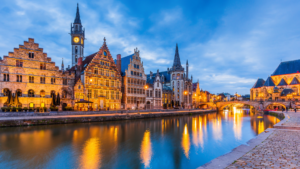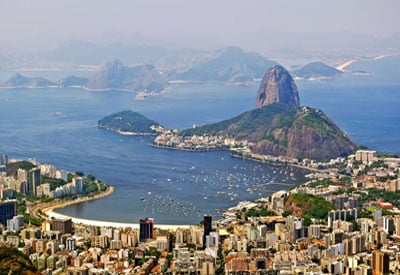The Kingdom of Belgium is a state in Western Europe. Belgium covers an area of 30,528 square kilometers (11,787 sq mi), and it has a population of about 10.8 million people. Straddling the cultural boundary between Germanic and Latin Europe, Belgium is home to two main linguistic groups, the Dutch-speakers, mostly Flemish, and the French-speakers, mostly Walloons, plus a small group of German-speakers. Belgium’s two largest regions are the Dutch-speaking region of Flanders in the north and the French-speaking southern region of Wallonia. The Brussels-Capital Region, officially bilingual, is a mostly French-speaking enclave within the Flemish Region. A small German-speaking Community exists in eastern Wallonia. Belgium’s linguistic diversity and related political and cultural conflicts are reflected in the political history and a complex system of government.
Historically, Belgium, the Netherlands and Luxembourg were known as the Low Countries, which used to cover a somewhat larger area than the current Benelux group of states. The region was called Belgica in Latin because of the Roman province Gallia Belgica which covered more or less the same area. From the end of the Middle Ages until the 17th century, it was a prosperous centre of commerce and culture. From the 16th century until the Belgian Revolution in 1830, when Belgium seceded from the Netherlands, many battles between European powers were fought in the area of Belgium, causing it to be dubbed the battleground of Europe, a reputation strengthened by both World Wars.
Upon its independence, Belgium eagerly participated in the Industrial Revolution and, during the course of the 20th century, possessed a number of colonies in Africa. The second half of the 20th century was marked by the rise of communal conflicts between the Flemings and the Francophones fuelled by cultural differences on the one hand and an asymmetrical economic evolution of Flanders and Wallonia on the other hand. These still-active conflicts have caused far-reaching reforms of the formerly unitary Belgian state into a federal state which might lead to a partition of the country.
In this Country Profile
:: Background of Belgium ::
Belgium became independent from the Netherlands in 1830; it was occupied by Germany during World Wars I and II. The country prospered in the past half century as a modern, technologically advanced European state and member of NATO and the EU. Tensions between the Dutch-speaking Flemings of the north and the French-speaking Walloons of the south have led in recent years to constitutional amendments granting these regions formal recognition and autonomy.
:: Geography of Belgium ::
Location: Western Europe, bordering the North Sea, between France and the Netherlands
Geographic coordinates: 50 50 N, 4 00 E
Area:
total: 30,528 sq km
land: 30,278 sq km
water: 250 sq km
Area – comparative: about the size of Maryland
Land boundaries: 1,385 km
Border countries: Czech France 620 km, Germany 167 km, Luxembourg 148 km, Netherlands 450 km
Coastline: 66.5 km
Maritime claims:
territorial sea: 12 nm
contiguous zone: 24 nm
exclusive economic zone: geographic coordinates define outer limit
continental shelf: median line with neighbors
Climate: temperate; mild winters, cool summers; rainy, humid, cloudy
Terrain: flat coastal plains in northwest, central rolling hills, rugged mountains of Ardennes Forest in southeast
Elevation extremes:
lowest point: North Sea 0 m
highest point: Botrange 694 m
Natural resources: construction materials, silica sand, carbonates
Land use:
arable land: 27.42%
permanent crops: 0.69%
other: 71.89%
note: includes Luxembourg (2005)
Irrigated land: 400 sq km (2003)
Total renewable water resources: 20.8 cu km (2005)
Freshwater withdrawal (domestic/industrial/agricultural):
total: 7.44 cu km/yr (13%/85%/1%)
per capita: 714 cu m/yr (1998)
Natural hazards: flooding is a threat along rivers and in areas of reclaimed coastal land, protected from the sea by concrete dikes
Environment – current issues: the environment is exposed to intense pressures from human activities: urbanization, dense transportation network, industry, extensive animal breeding and crop cultivation; air and water pollution also have repercussions for neighboring countries; uncertainties regarding federal and regional responsibilities (now resolved) had slowed progress in tackling environmental challenges
Environment – international agreements: party to: Air Pollution, Air Pollution-Nitrogen Oxides, Air Pollution-Persistent Organic Pollutants, Air Pollution-Sulfur 85, Air Pollution-Sulfur 94, Air Pollution-Volatile Organic Compounds, Antarctic-Environmental Protocol, Antarctic-Marine Living Resources, Antarctic Seals, Antarctic Treaty, Biodiversity, Climate Change, Climate Change-Kyoto Protocol, Desertification, Endangered Species, Environmental Modification, Hazardous Wastes, Law of the Sea, Marine Dumping, Marine Life Conservation, Ozone Layer Protection, Ship Pollution, Tropical Timber 83, Tropical Timber 94, Wetlands, Whaling; signed, but not ratified: none of the selected agreements
Geography – note: crossroads of Western Europe; most West European capitals within 1,000 km of Brussels, the seat of both the European Union and NATO
:: People of Belgium ::
Population: 10,431,477 (July 2011 est.)
Age structure:
0-14 years: 15.9% (male 846,706/female 812,486)
15-64 years: 66.1% (male 3,475,404/female 3,416,060)
65 years and over: 18% (male 783,895/female 1,096,926) (2011 est.)
Median age:
total: 42.3 years
male: 41 years
female: 43.6 years (2011 est.)
Population growth rate: 0.071% (2011 est.)
Birth rate: 10.06 births/1,000 population (2011 est.)
Death rate: 10.57 deaths/1,000 population (July 2011 est.)
Net migration rate: 1.22 migrant(s)/1,000 population (2011 est.)
Urbanization:
urban population: 97% of total population (2010)
rate of urbanization: 0.4% annual rate of change (2010-15 est.)
Sex ratio:
at birth: 1.045 male(s)/female
under 15 years: 1.04 male(s)/female
15-64 years: 1.02 male(s)/female
65 years and over: 0.71 male(s)/female
total population: 0.96 male(s)/female (2011 est.)
Infant mortality rate:
total: 4.33 deaths/1,000 live births
male: 4.86 deaths/1,000 live births
female: 3.78 deaths/1,000 live births (2011 est.)
Life expectancy at birth:
total population: 79.51 years
male: 76.35 years
female: 82.81 years (2011 est.)
Total fertility rate: 1.65 children born/woman (2011 est.)
HIV/AIDS – adult prevalence rate: 0.2% (2009 est.)
HIV/AIDS – people living with HIV/AIDS: 14,000 (2009 est.)
HIV/AIDS – deaths: fewer than 100 (2009 est.)
Nationality: noun: Belgian(s) adjective: Belgian
Ethnic groups: Fleming 58%, Walloon 31%, mixed or other 11%
Religions: Roman Catholic 75%, other (includes Protestant) 25%
Languages: Dutch (official) 60%, French (official) 40%, German (official) less than 1%, legally bilingual (Dutch and French)
Literacy:
definition: age 15 and over can read and write
total population: 99%
male: 99%
female: 99%
School life expectancy (primary to tertiary education):
total: 16 years
male: 16 years
female: 16 years (2008)
Education expenditures: 6.1% of GDP (2007)


Sorry, the comment form is closed at this time.